Comparative Analysis of Life Expectancy in New Zealand and India
VerifiedAdded on 2020/04/29
|12
|3563
|64
Report
AI Summary
This report provides a comparative analysis of life expectancy between New Zealand and India, examining key demographic and health indicators. It begins with an introduction to life expectancy as a statistical measure and then compares and contrasts life expectancy rates, infant mortality, and birth...
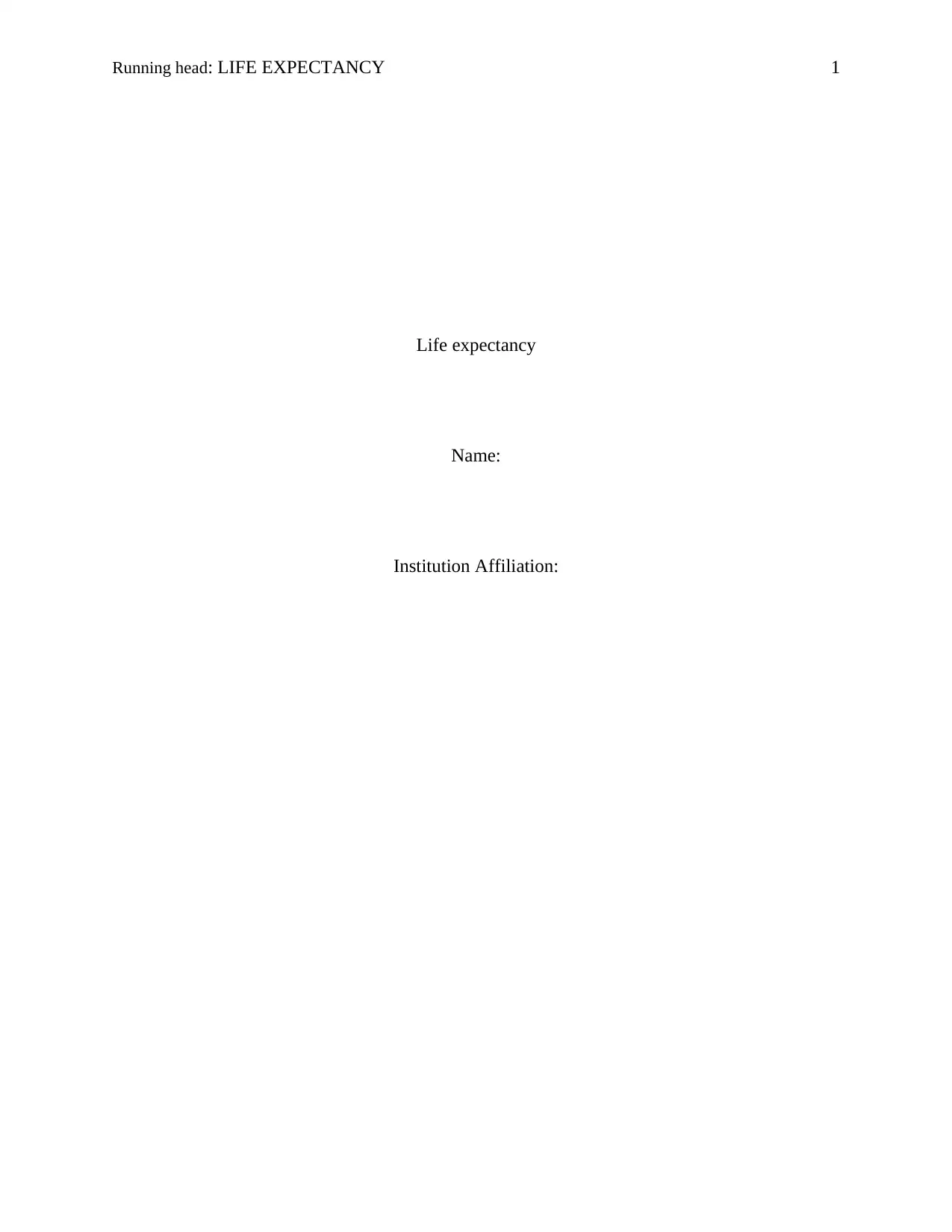
Running head: LIFE EXPECTANCY 1
Life expectancy
Name:
Institution Affiliation:
Life expectancy
Name:
Institution Affiliation:
Paraphrase This Document
Need a fresh take? Get an instant paraphrase of this document with our AI Paraphraser
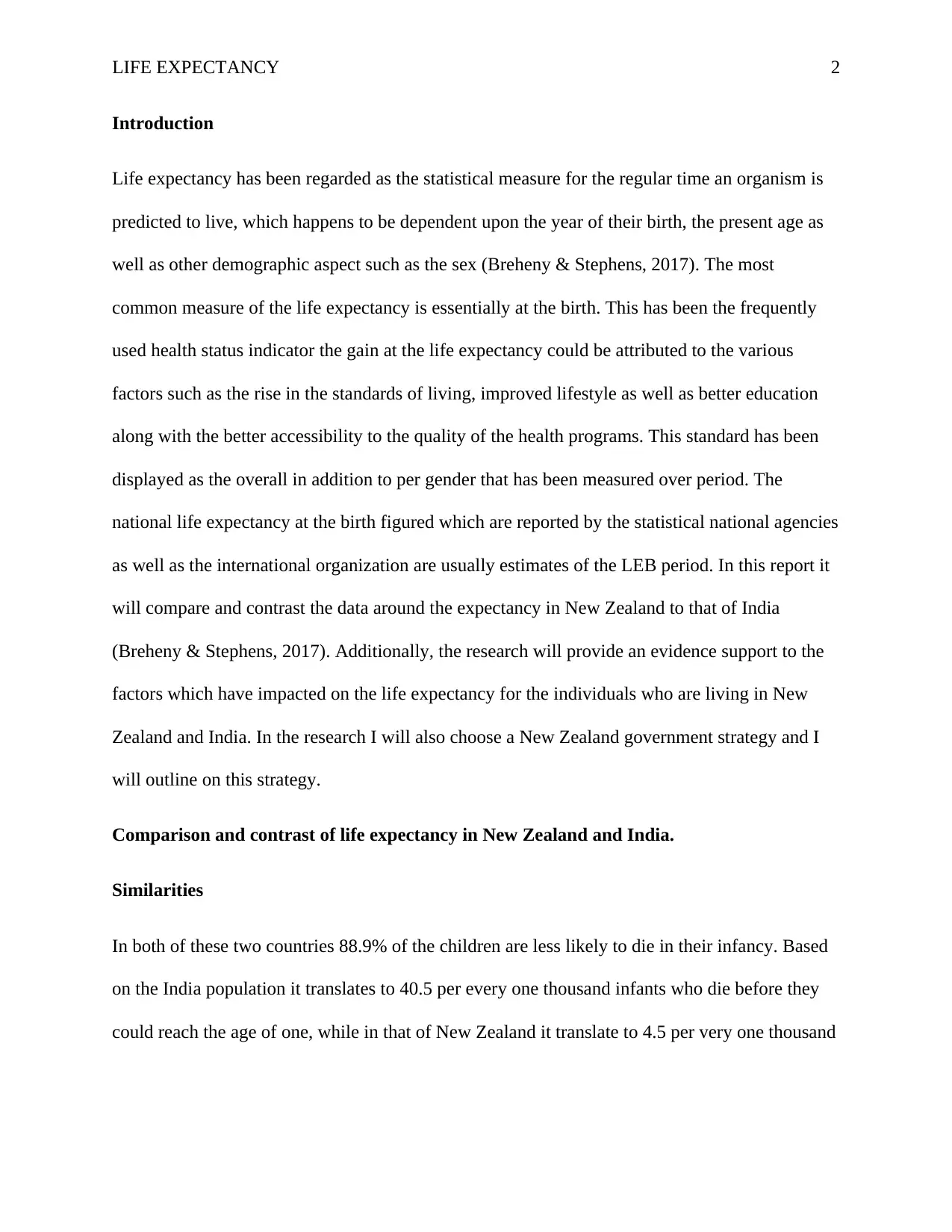
LIFE EXPECTANCY 2
Introduction
Life expectancy has been regarded as the statistical measure for the regular time an organism is
predicted to live, which happens to be dependent upon the year of their birth, the present age as
well as other demographic aspect such as the sex (Breheny & Stephens, 2017). The most
common measure of the life expectancy is essentially at the birth. This has been the frequently
used health status indicator the gain at the life expectancy could be attributed to the various
factors such as the rise in the standards of living, improved lifestyle as well as better education
along with the better accessibility to the quality of the health programs. This standard has been
displayed as the overall in addition to per gender that has been measured over period. The
national life expectancy at the birth figured which are reported by the statistical national agencies
as well as the international organization are usually estimates of the LEB period. In this report it
will compare and contrast the data around the expectancy in New Zealand to that of India
(Breheny & Stephens, 2017). Additionally, the research will provide an evidence support to the
factors which have impacted on the life expectancy for the individuals who are living in New
Zealand and India. In the research I will also choose a New Zealand government strategy and I
will outline on this strategy.
Comparison and contrast of life expectancy in New Zealand and India.
Similarities
In both of these two countries 88.9% of the children are less likely to die in their infancy. Based
on the India population it translates to 40.5 per every one thousand infants who die before they
could reach the age of one, while in that of New Zealand it translate to 4.5 per very one thousand
Introduction
Life expectancy has been regarded as the statistical measure for the regular time an organism is
predicted to live, which happens to be dependent upon the year of their birth, the present age as
well as other demographic aspect such as the sex (Breheny & Stephens, 2017). The most
common measure of the life expectancy is essentially at the birth. This has been the frequently
used health status indicator the gain at the life expectancy could be attributed to the various
factors such as the rise in the standards of living, improved lifestyle as well as better education
along with the better accessibility to the quality of the health programs. This standard has been
displayed as the overall in addition to per gender that has been measured over period. The
national life expectancy at the birth figured which are reported by the statistical national agencies
as well as the international organization are usually estimates of the LEB period. In this report it
will compare and contrast the data around the expectancy in New Zealand to that of India
(Breheny & Stephens, 2017). Additionally, the research will provide an evidence support to the
factors which have impacted on the life expectancy for the individuals who are living in New
Zealand and India. In the research I will also choose a New Zealand government strategy and I
will outline on this strategy.
Comparison and contrast of life expectancy in New Zealand and India.
Similarities
In both of these two countries 88.9% of the children are less likely to die in their infancy. Based
on the India population it translates to 40.5 per every one thousand infants who die before they
could reach the age of one, while in that of New Zealand it translate to 4.5 per very one thousand
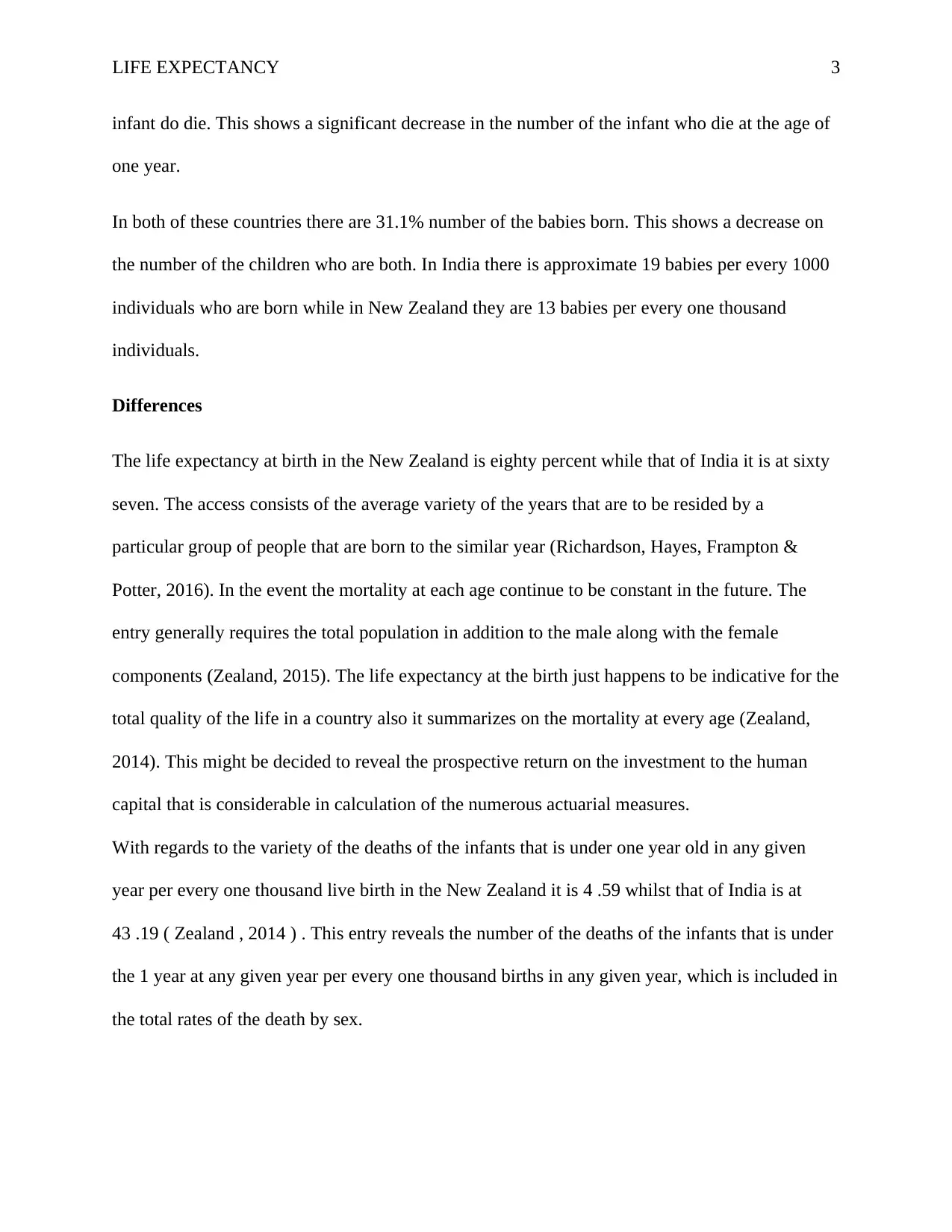
LIFE EXPECTANCY 3
infant do die. This shows a significant decrease in the number of the infant who die at the age of
one year.
In both of these countries there are 31.1% number of the babies born. This shows a decrease on
the number of the children who are both. In India there is approximate 19 babies per every 1000
individuals who are born while in New Zealand they are 13 babies per every one thousand
individuals.
Differences
The life expectancy at birth in the New Zealand is eighty percent while that of India it is at sixty
seven. The access consists of the average variety of the years that are to be resided by a
particular group of people that are born to the similar year (Richardson, Hayes, Frampton &
Potter, 2016). In the event the mortality at each age continue to be constant in the future. The
entry generally requires the total population in addition to the male along with the female
components (Zealand, 2015). The life expectancy at the birth just happens to be indicative for the
total quality of the life in a country also it summarizes on the mortality at every age (Zealand,
2014). This might be decided to reveal the prospective return on the investment to the human
capital that is considerable in calculation of the numerous actuarial measures.
With regards to the variety of the deaths of the infants that is under one year old in any given
year per every one thousand live birth in the New Zealand it is 4 .59 whilst that of India is at
43 .19 ( Zealand , 2014 ) . This entry reveals the number of the deaths of the infants that is under
the 1 year at any given year per every one thousand births in any given year, which is included in
the total rates of the death by sex.
infant do die. This shows a significant decrease in the number of the infant who die at the age of
one year.
In both of these countries there are 31.1% number of the babies born. This shows a decrease on
the number of the children who are both. In India there is approximate 19 babies per every 1000
individuals who are born while in New Zealand they are 13 babies per every one thousand
individuals.
Differences
The life expectancy at birth in the New Zealand is eighty percent while that of India it is at sixty
seven. The access consists of the average variety of the years that are to be resided by a
particular group of people that are born to the similar year (Richardson, Hayes, Frampton &
Potter, 2016). In the event the mortality at each age continue to be constant in the future. The
entry generally requires the total population in addition to the male along with the female
components (Zealand, 2015). The life expectancy at the birth just happens to be indicative for the
total quality of the life in a country also it summarizes on the mortality at every age (Zealand,
2014). This might be decided to reveal the prospective return on the investment to the human
capital that is considerable in calculation of the numerous actuarial measures.
With regards to the variety of the deaths of the infants that is under one year old in any given
year per every one thousand live birth in the New Zealand it is 4 .59 whilst that of India is at
43 .19 ( Zealand , 2014 ) . This entry reveals the number of the deaths of the infants that is under
the 1 year at any given year per every one thousand births in any given year, which is included in
the total rates of the death by sex.
⊘ This is a preview!⊘
Do you want full access?
Subscribe today to unlock all pages.

Trusted by 1+ million students worldwide
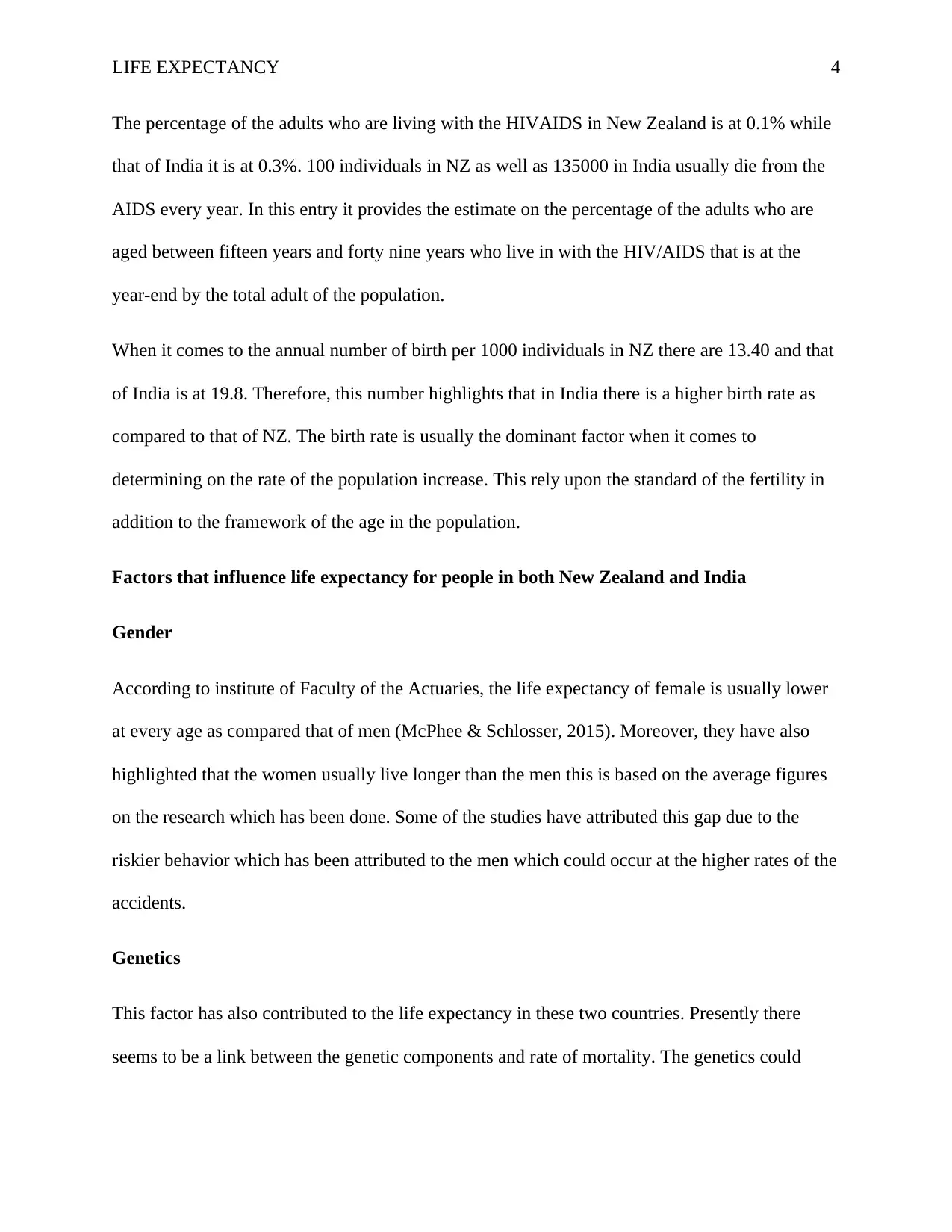
LIFE EXPECTANCY 4
The percentage of the adults who are living with the HIVAIDS in New Zealand is at 0.1% while
that of India it is at 0.3%. 100 individuals in NZ as well as 135000 in India usually die from the
AIDS every year. In this entry it provides the estimate on the percentage of the adults who are
aged between fifteen years and forty nine years who live in with the HIV/AIDS that is at the
year-end by the total adult of the population.
When it comes to the annual number of birth per 1000 individuals in NZ there are 13.40 and that
of India is at 19.8. Therefore, this number highlights that in India there is a higher birth rate as
compared to that of NZ. The birth rate is usually the dominant factor when it comes to
determining on the rate of the population increase. This rely upon the standard of the fertility in
addition to the framework of the age in the population.
Factors that influence life expectancy for people in both New Zealand and India
Gender
According to institute of Faculty of the Actuaries, the life expectancy of female is usually lower
at every age as compared that of men (McPhee & Schlosser, 2015). Moreover, they have also
highlighted that the women usually live longer than the men this is based on the average figures
on the research which has been done. Some of the studies have attributed this gap due to the
riskier behavior which has been attributed to the men which could occur at the higher rates of the
accidents.
Genetics
This factor has also contributed to the life expectancy in these two countries. Presently there
seems to be a link between the genetic components and rate of mortality. The genetics could
The percentage of the adults who are living with the HIVAIDS in New Zealand is at 0.1% while
that of India it is at 0.3%. 100 individuals in NZ as well as 135000 in India usually die from the
AIDS every year. In this entry it provides the estimate on the percentage of the adults who are
aged between fifteen years and forty nine years who live in with the HIV/AIDS that is at the
year-end by the total adult of the population.
When it comes to the annual number of birth per 1000 individuals in NZ there are 13.40 and that
of India is at 19.8. Therefore, this number highlights that in India there is a higher birth rate as
compared to that of NZ. The birth rate is usually the dominant factor when it comes to
determining on the rate of the population increase. This rely upon the standard of the fertility in
addition to the framework of the age in the population.
Factors that influence life expectancy for people in both New Zealand and India
Gender
According to institute of Faculty of the Actuaries, the life expectancy of female is usually lower
at every age as compared that of men (McPhee & Schlosser, 2015). Moreover, they have also
highlighted that the women usually live longer than the men this is based on the average figures
on the research which has been done. Some of the studies have attributed this gap due to the
riskier behavior which has been attributed to the men which could occur at the higher rates of the
accidents.
Genetics
This factor has also contributed to the life expectancy in these two countries. Presently there
seems to be a link between the genetic components and rate of mortality. The genetics could
Paraphrase This Document
Need a fresh take? Get an instant paraphrase of this document with our AI Paraphraser
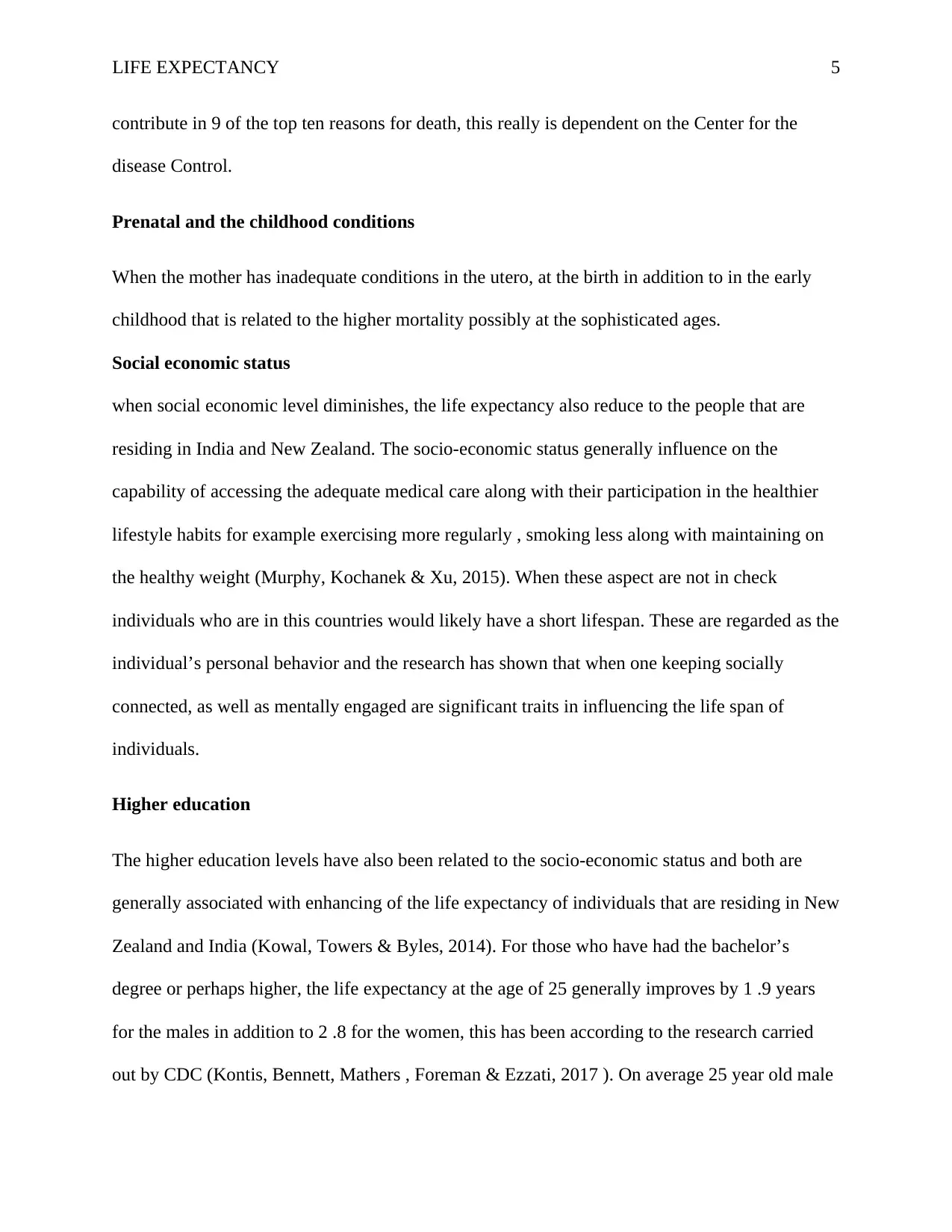
LIFE EXPECTANCY 5
contribute in 9 of the top ten reasons for death, this really is dependent on the Center for the
disease Control.
Prenatal and the childhood conditions
When the mother has inadequate conditions in the utero, at the birth in addition to in the early
childhood that is related to the higher mortality possibly at the sophisticated ages.
Social economic status
when social economic level diminishes, the life expectancy also reduce to the people that are
residing in India and New Zealand. The socio-economic status generally influence on the
capability of accessing the adequate medical care along with their participation in the healthier
lifestyle habits for example exercising more regularly , smoking less along with maintaining on
the healthy weight (Murphy, Kochanek & Xu, 2015). When these aspect are not in check
individuals who are in this countries would likely have a short lifespan. These are regarded as the
individual’s personal behavior and the research has shown that when one keeping socially
connected, as well as mentally engaged are significant traits in influencing the life span of
individuals.
Higher education
The higher education levels have also been related to the socio-economic status and both are
generally associated with enhancing of the life expectancy of individuals that are residing in New
Zealand and India (Kowal, Towers & Byles, 2014). For those who have had the bachelor’s
degree or perhaps higher, the life expectancy at the age of 25 generally improves by 1 .9 years
for the males in addition to 2 .8 for the women, this has been according to the research carried
out by CDC (Kontis, Bennett, Mathers , Foreman & Ezzati, 2017 ). On average 25 year old male
contribute in 9 of the top ten reasons for death, this really is dependent on the Center for the
disease Control.
Prenatal and the childhood conditions
When the mother has inadequate conditions in the utero, at the birth in addition to in the early
childhood that is related to the higher mortality possibly at the sophisticated ages.
Social economic status
when social economic level diminishes, the life expectancy also reduce to the people that are
residing in India and New Zealand. The socio-economic status generally influence on the
capability of accessing the adequate medical care along with their participation in the healthier
lifestyle habits for example exercising more regularly , smoking less along with maintaining on
the healthy weight (Murphy, Kochanek & Xu, 2015). When these aspect are not in check
individuals who are in this countries would likely have a short lifespan. These are regarded as the
individual’s personal behavior and the research has shown that when one keeping socially
connected, as well as mentally engaged are significant traits in influencing the life span of
individuals.
Higher education
The higher education levels have also been related to the socio-economic status and both are
generally associated with enhancing of the life expectancy of individuals that are residing in New
Zealand and India (Kowal, Towers & Byles, 2014). For those who have had the bachelor’s
degree or perhaps higher, the life expectancy at the age of 25 generally improves by 1 .9 years
for the males in addition to 2 .8 for the women, this has been according to the research carried
out by CDC (Kontis, Bennett, Mathers , Foreman & Ezzati, 2017 ). On average 25 year old male
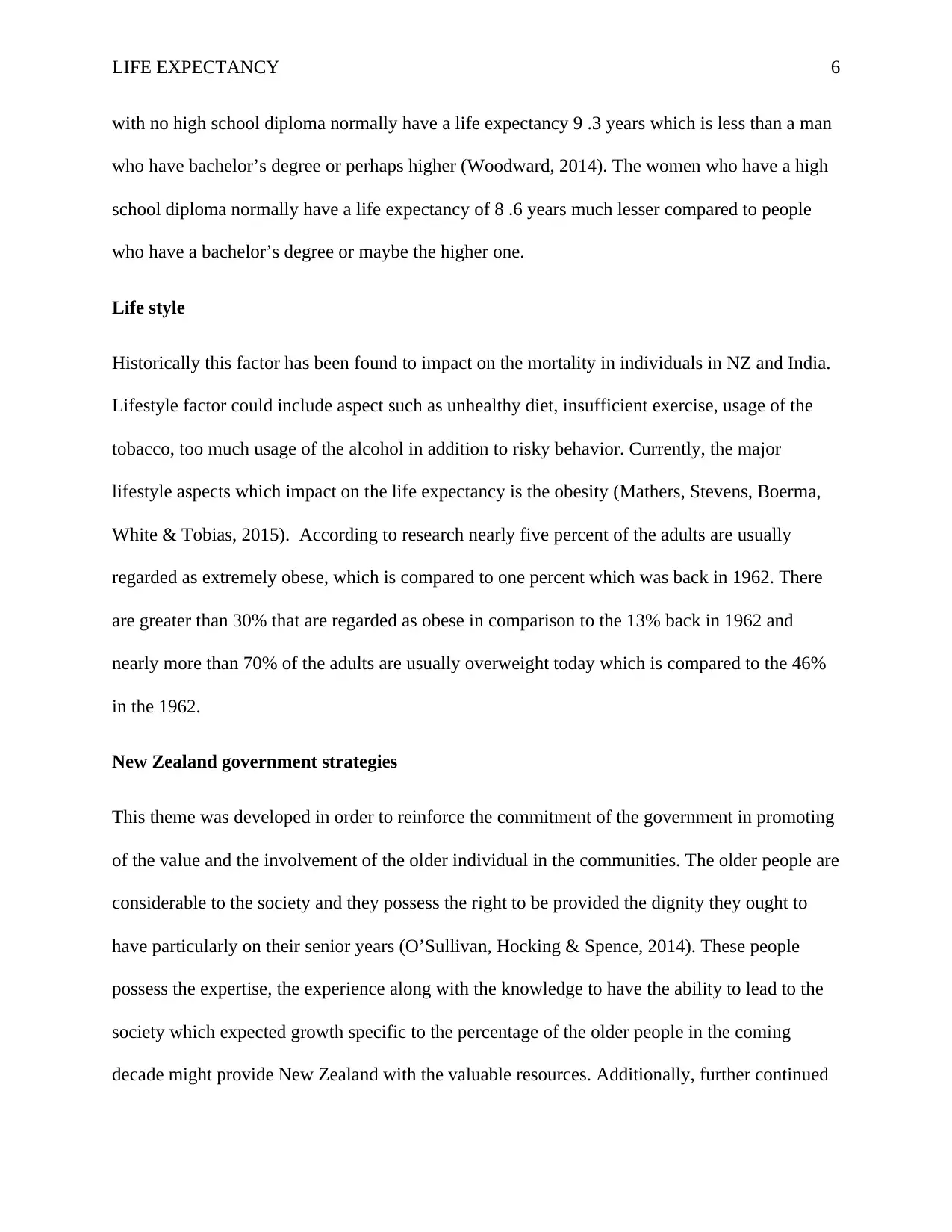
LIFE EXPECTANCY 6
with no high school diploma normally have a life expectancy 9 .3 years which is less than a man
who have bachelor’s degree or perhaps higher (Woodward, 2014). The women who have a high
school diploma normally have a life expectancy of 8 .6 years much lesser compared to people
who have a bachelor’s degree or maybe the higher one.
Life style
Historically this factor has been found to impact on the mortality in individuals in NZ and India.
Lifestyle factor could include aspect such as unhealthy diet, insufficient exercise, usage of the
tobacco, too much usage of the alcohol in addition to risky behavior. Currently, the major
lifestyle aspects which impact on the life expectancy is the obesity (Mathers, Stevens, Boerma,
White & Tobias, 2015). According to research nearly five percent of the adults are usually
regarded as extremely obese, which is compared to one percent which was back in 1962. There
are greater than 30% that are regarded as obese in comparison to the 13% back in 1962 and
nearly more than 70% of the adults are usually overweight today which is compared to the 46%
in the 1962.
New Zealand government strategies
This theme was developed in order to reinforce the commitment of the government in promoting
of the value and the involvement of the older individual in the communities. The older people are
considerable to the society and they possess the right to be provided the dignity they ought to
have particularly on their senior years (O’Sullivan, Hocking & Spence, 2014). These people
possess the expertise, the experience along with the knowledge to have the ability to lead to the
society which expected growth specific to the percentage of the older people in the coming
decade might provide New Zealand with the valuable resources. Additionally, further continued
with no high school diploma normally have a life expectancy 9 .3 years which is less than a man
who have bachelor’s degree or perhaps higher (Woodward, 2014). The women who have a high
school diploma normally have a life expectancy of 8 .6 years much lesser compared to people
who have a bachelor’s degree or maybe the higher one.
Life style
Historically this factor has been found to impact on the mortality in individuals in NZ and India.
Lifestyle factor could include aspect such as unhealthy diet, insufficient exercise, usage of the
tobacco, too much usage of the alcohol in addition to risky behavior. Currently, the major
lifestyle aspects which impact on the life expectancy is the obesity (Mathers, Stevens, Boerma,
White & Tobias, 2015). According to research nearly five percent of the adults are usually
regarded as extremely obese, which is compared to one percent which was back in 1962. There
are greater than 30% that are regarded as obese in comparison to the 13% back in 1962 and
nearly more than 70% of the adults are usually overweight today which is compared to the 46%
in the 1962.
New Zealand government strategies
This theme was developed in order to reinforce the commitment of the government in promoting
of the value and the involvement of the older individual in the communities. The older people are
considerable to the society and they possess the right to be provided the dignity they ought to
have particularly on their senior years (O’Sullivan, Hocking & Spence, 2014). These people
possess the expertise, the experience along with the knowledge to have the ability to lead to the
society which expected growth specific to the percentage of the older people in the coming
decade might provide New Zealand with the valuable resources. Additionally, further continued
⊘ This is a preview!⊘
Do you want full access?
Subscribe today to unlock all pages.

Trusted by 1+ million students worldwide
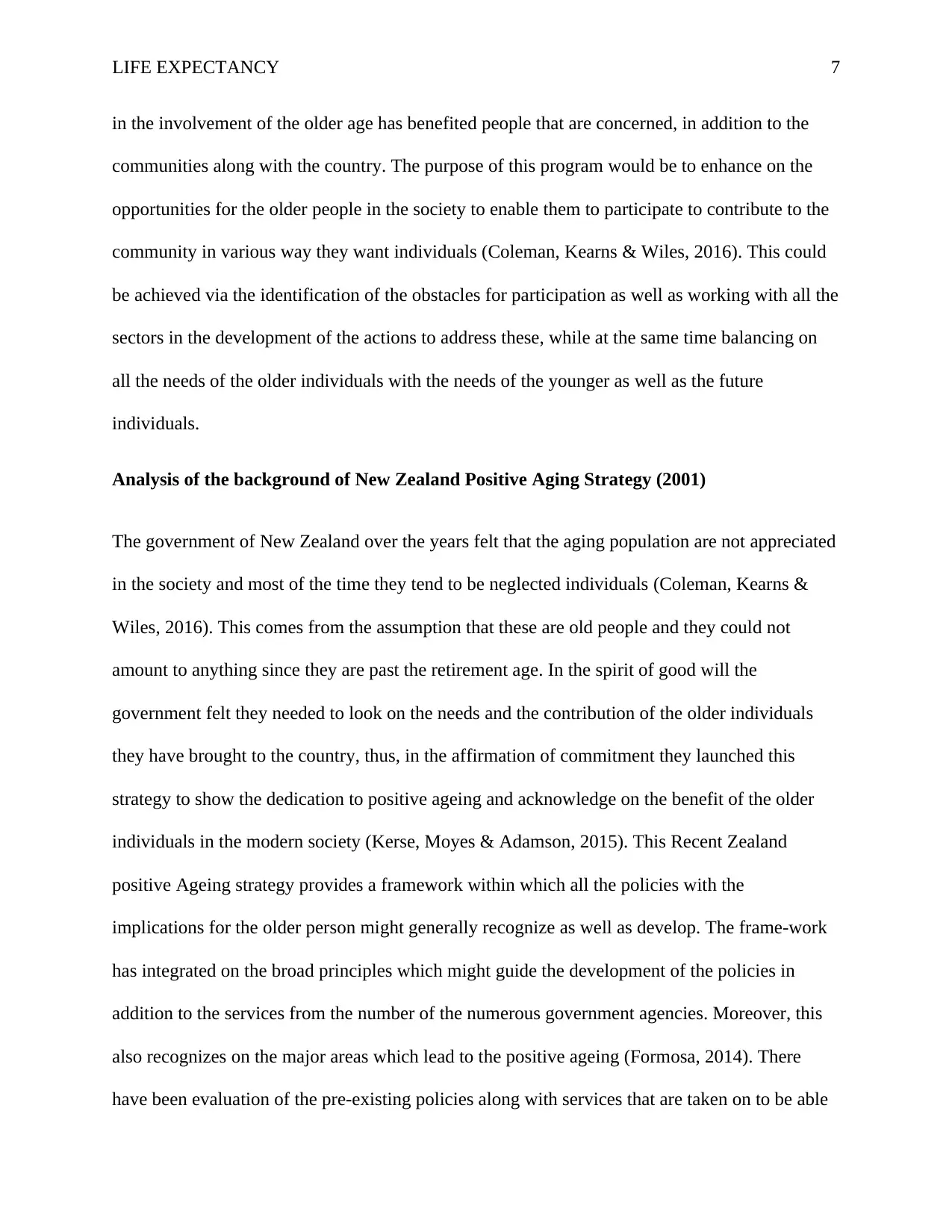
LIFE EXPECTANCY 7
in the involvement of the older age has benefited people that are concerned, in addition to the
communities along with the country. The purpose of this program would be to enhance on the
opportunities for the older people in the society to enable them to participate to contribute to the
community in various way they want individuals (Coleman, Kearns & Wiles, 2016). This could
be achieved via the identification of the obstacles for participation as well as working with all the
sectors in the development of the actions to address these, while at the same time balancing on
all the needs of the older individuals with the needs of the younger as well as the future
individuals.
Analysis of the background of New Zealand Positive Aging Strategy (2001)
The government of New Zealand over the years felt that the aging population are not appreciated
in the society and most of the time they tend to be neglected individuals (Coleman, Kearns &
Wiles, 2016). This comes from the assumption that these are old people and they could not
amount to anything since they are past the retirement age. In the spirit of good will the
government felt they needed to look on the needs and the contribution of the older individuals
they have brought to the country, thus, in the affirmation of commitment they launched this
strategy to show the dedication to positive ageing and acknowledge on the benefit of the older
individuals in the modern society (Kerse, Moyes & Adamson, 2015). This Recent Zealand
positive Ageing strategy provides a framework within which all the policies with the
implications for the older person might generally recognize as well as develop. The frame-work
has integrated on the broad principles which might guide the development of the policies in
addition to the services from the number of the numerous government agencies. Moreover, this
also recognizes on the major areas which lead to the positive ageing (Formosa, 2014). There
have been evaluation of the pre-existing policies along with services that are taken on to be able
in the involvement of the older age has benefited people that are concerned, in addition to the
communities along with the country. The purpose of this program would be to enhance on the
opportunities for the older people in the society to enable them to participate to contribute to the
community in various way they want individuals (Coleman, Kearns & Wiles, 2016). This could
be achieved via the identification of the obstacles for participation as well as working with all the
sectors in the development of the actions to address these, while at the same time balancing on
all the needs of the older individuals with the needs of the younger as well as the future
individuals.
Analysis of the background of New Zealand Positive Aging Strategy (2001)
The government of New Zealand over the years felt that the aging population are not appreciated
in the society and most of the time they tend to be neglected individuals (Coleman, Kearns &
Wiles, 2016). This comes from the assumption that these are old people and they could not
amount to anything since they are past the retirement age. In the spirit of good will the
government felt they needed to look on the needs and the contribution of the older individuals
they have brought to the country, thus, in the affirmation of commitment they launched this
strategy to show the dedication to positive ageing and acknowledge on the benefit of the older
individuals in the modern society (Kerse, Moyes & Adamson, 2015). This Recent Zealand
positive Ageing strategy provides a framework within which all the policies with the
implications for the older person might generally recognize as well as develop. The frame-work
has integrated on the broad principles which might guide the development of the policies in
addition to the services from the number of the numerous government agencies. Moreover, this
also recognizes on the major areas which lead to the positive ageing (Formosa, 2014). There
have been evaluation of the pre-existing policies along with services that are taken on to be able
Paraphrase This Document
Need a fresh take? Get an instant paraphrase of this document with our AI Paraphraser
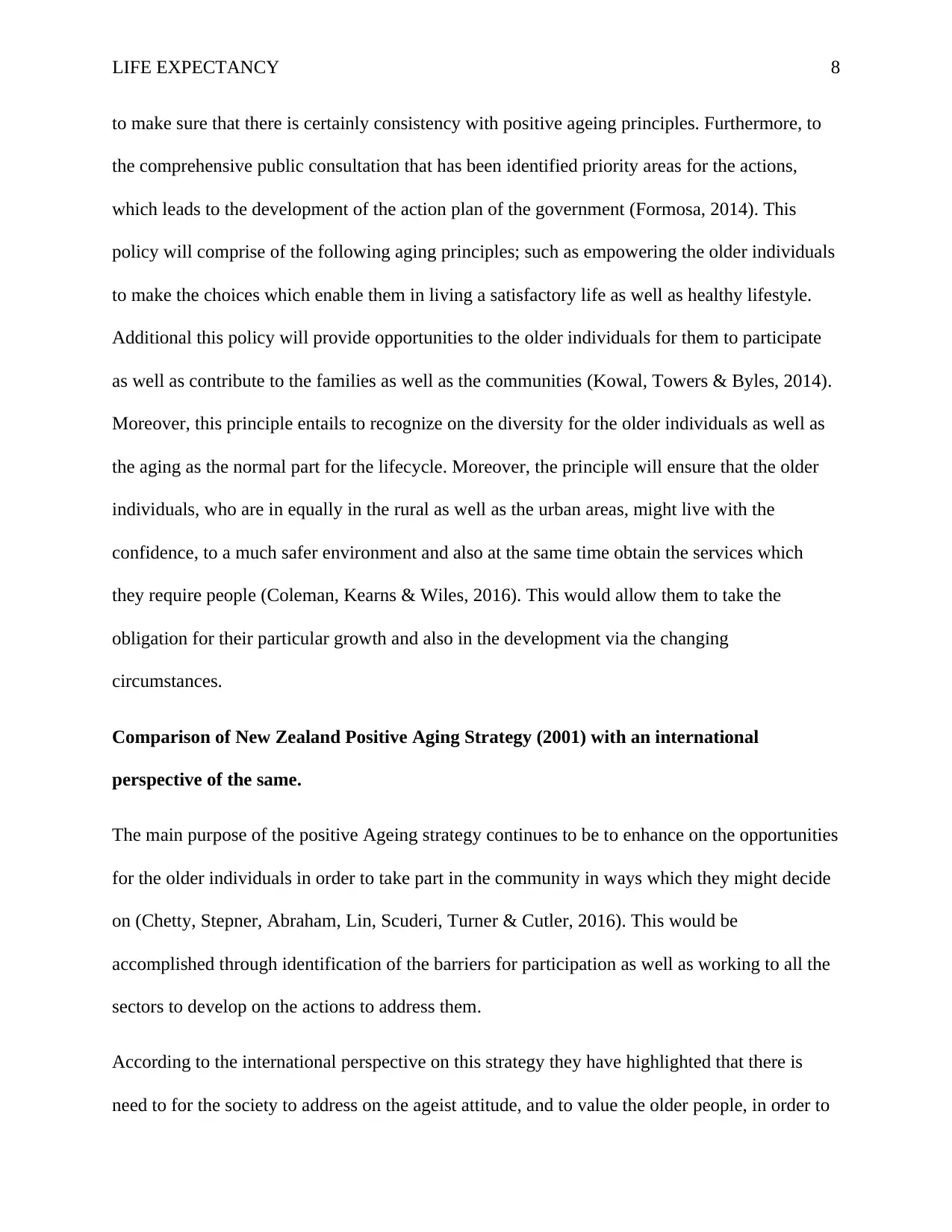
LIFE EXPECTANCY 8
to make sure that there is certainly consistency with positive ageing principles. Furthermore, to
the comprehensive public consultation that has been identified priority areas for the actions,
which leads to the development of the action plan of the government (Formosa, 2014). This
policy will comprise of the following aging principles; such as empowering the older individuals
to make the choices which enable them in living a satisfactory life as well as healthy lifestyle.
Additional this policy will provide opportunities to the older individuals for them to participate
as well as contribute to the families as well as the communities (Kowal, Towers & Byles, 2014).
Moreover, this principle entails to recognize on the diversity for the older individuals as well as
the aging as the normal part for the lifecycle. Moreover, the principle will ensure that the older
individuals, who are in equally in the rural as well as the urban areas, might live with the
confidence, to a much safer environment and also at the same time obtain the services which
they require people (Coleman, Kearns & Wiles, 2016). This would allow them to take the
obligation for their particular growth and also in the development via the changing
circumstances.
Comparison of New Zealand Positive Aging Strategy (2001) with an international
perspective of the same.
The main purpose of the positive Ageing strategy continues to be to enhance on the opportunities
for the older individuals in order to take part in the community in ways which they might decide
on (Chetty, Stepner, Abraham, Lin, Scuderi, Turner & Cutler, 2016). This would be
accomplished through identification of the barriers for participation as well as working to all the
sectors to develop on the actions to address them.
According to the international perspective on this strategy they have highlighted that there is
need to for the society to address on the ageist attitude, and to value the older people, in order to
to make sure that there is certainly consistency with positive ageing principles. Furthermore, to
the comprehensive public consultation that has been identified priority areas for the actions,
which leads to the development of the action plan of the government (Formosa, 2014). This
policy will comprise of the following aging principles; such as empowering the older individuals
to make the choices which enable them in living a satisfactory life as well as healthy lifestyle.
Additional this policy will provide opportunities to the older individuals for them to participate
as well as contribute to the families as well as the communities (Kowal, Towers & Byles, 2014).
Moreover, this principle entails to recognize on the diversity for the older individuals as well as
the aging as the normal part for the lifecycle. Moreover, the principle will ensure that the older
individuals, who are in equally in the rural as well as the urban areas, might live with the
confidence, to a much safer environment and also at the same time obtain the services which
they require people (Coleman, Kearns & Wiles, 2016). This would allow them to take the
obligation for their particular growth and also in the development via the changing
circumstances.
Comparison of New Zealand Positive Aging Strategy (2001) with an international
perspective of the same.
The main purpose of the positive Ageing strategy continues to be to enhance on the opportunities
for the older individuals in order to take part in the community in ways which they might decide
on (Chetty, Stepner, Abraham, Lin, Scuderi, Turner & Cutler, 2016). This would be
accomplished through identification of the barriers for participation as well as working to all the
sectors to develop on the actions to address them.
According to the international perspective on this strategy they have highlighted that there is
need to for the society to address on the ageist attitude, and to value the older people, in order to
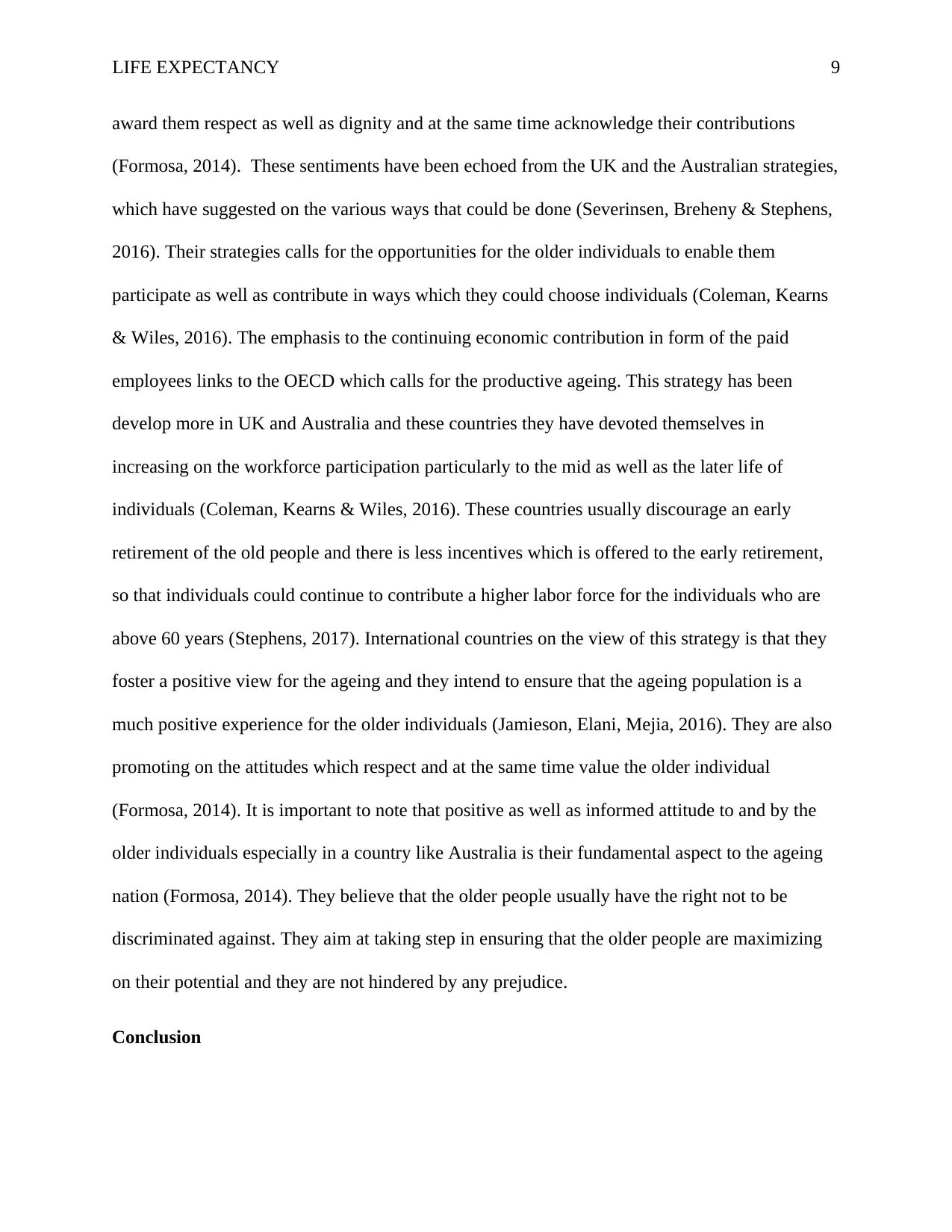
LIFE EXPECTANCY 9
award them respect as well as dignity and at the same time acknowledge their contributions
(Formosa, 2014). These sentiments have been echoed from the UK and the Australian strategies,
which have suggested on the various ways that could be done (Severinsen, Breheny & Stephens,
2016). Their strategies calls for the opportunities for the older individuals to enable them
participate as well as contribute in ways which they could choose individuals (Coleman, Kearns
& Wiles, 2016). The emphasis to the continuing economic contribution in form of the paid
employees links to the OECD which calls for the productive ageing. This strategy has been
develop more in UK and Australia and these countries they have devoted themselves in
increasing on the workforce participation particularly to the mid as well as the later life of
individuals (Coleman, Kearns & Wiles, 2016). These countries usually discourage an early
retirement of the old people and there is less incentives which is offered to the early retirement,
so that individuals could continue to contribute a higher labor force for the individuals who are
above 60 years (Stephens, 2017). International countries on the view of this strategy is that they
foster a positive view for the ageing and they intend to ensure that the ageing population is a
much positive experience for the older individuals (Jamieson, Elani, Mejia, 2016). They are also
promoting on the attitudes which respect and at the same time value the older individual
(Formosa, 2014). It is important to note that positive as well as informed attitude to and by the
older individuals especially in a country like Australia is their fundamental aspect to the ageing
nation (Formosa, 2014). They believe that the older people usually have the right not to be
discriminated against. They aim at taking step in ensuring that the older people are maximizing
on their potential and they are not hindered by any prejudice.
Conclusion
award them respect as well as dignity and at the same time acknowledge their contributions
(Formosa, 2014). These sentiments have been echoed from the UK and the Australian strategies,
which have suggested on the various ways that could be done (Severinsen, Breheny & Stephens,
2016). Their strategies calls for the opportunities for the older individuals to enable them
participate as well as contribute in ways which they could choose individuals (Coleman, Kearns
& Wiles, 2016). The emphasis to the continuing economic contribution in form of the paid
employees links to the OECD which calls for the productive ageing. This strategy has been
develop more in UK and Australia and these countries they have devoted themselves in
increasing on the workforce participation particularly to the mid as well as the later life of
individuals (Coleman, Kearns & Wiles, 2016). These countries usually discourage an early
retirement of the old people and there is less incentives which is offered to the early retirement,
so that individuals could continue to contribute a higher labor force for the individuals who are
above 60 years (Stephens, 2017). International countries on the view of this strategy is that they
foster a positive view for the ageing and they intend to ensure that the ageing population is a
much positive experience for the older individuals (Jamieson, Elani, Mejia, 2016). They are also
promoting on the attitudes which respect and at the same time value the older individual
(Formosa, 2014). It is important to note that positive as well as informed attitude to and by the
older individuals especially in a country like Australia is their fundamental aspect to the ageing
nation (Formosa, 2014). They believe that the older people usually have the right not to be
discriminated against. They aim at taking step in ensuring that the older people are maximizing
on their potential and they are not hindered by any prejudice.
Conclusion
⊘ This is a preview!⊘
Do you want full access?
Subscribe today to unlock all pages.

Trusted by 1+ million students worldwide
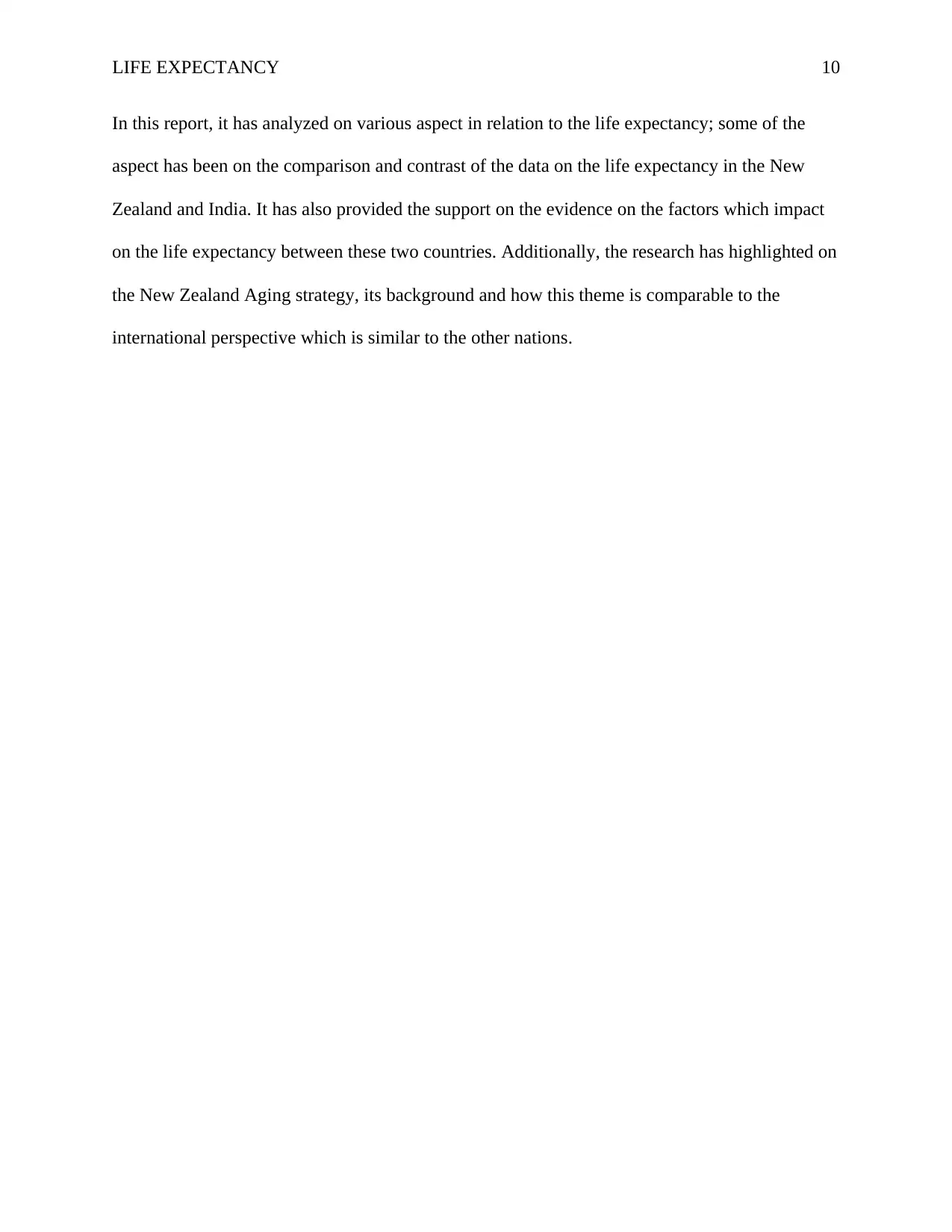
LIFE EXPECTANCY 10
In this report, it has analyzed on various aspect in relation to the life expectancy; some of the
aspect has been on the comparison and contrast of the data on the life expectancy in the New
Zealand and India. It has also provided the support on the evidence on the factors which impact
on the life expectancy between these two countries. Additionally, the research has highlighted on
the New Zealand Aging strategy, its background and how this theme is comparable to the
international perspective which is similar to the other nations.
In this report, it has analyzed on various aspect in relation to the life expectancy; some of the
aspect has been on the comparison and contrast of the data on the life expectancy in the New
Zealand and India. It has also provided the support on the evidence on the factors which impact
on the life expectancy between these two countries. Additionally, the research has highlighted on
the New Zealand Aging strategy, its background and how this theme is comparable to the
international perspective which is similar to the other nations.
Paraphrase This Document
Need a fresh take? Get an instant paraphrase of this document with our AI Paraphraser

LIFE EXPECTANCY 11
References
Breheny, M., & Stephens, C. (2017). Spending time: the discursive construction of leisure in
later life. Annals of Leisure Research, 20(1), 39-54.
Chetty, R., Stepner, M., Abraham, S., Lin, S., Scuderi, B., Turner, N., ... & Cutler, D. (2016).
The association between income and life expectancy in the United States, 2001-2014.
Jama, 315(16), 1750-1766.
Coleman, T., Kearns, R. A., & Wiles, J. (2016). Older adults’ experiences of home maintenance
issues and opportunities to maintain ageing in place. Housing Studies, 31(8), 964-983.
Formosa, M. (2014). Positive Aging in an Age of Neo-liberalism. Germany: Transcript Verlag.
Jamieson, L. M., Elani, H. W., Mejia, G. C., Ju, X., Kawachi, I., Harper, S., ... & Kaufman, J. S.
(2016). Inequalities in Indigenous oral health: findings from Australia, New Zealand, and
Canada. Journal of dental research, 95(12), 1375-1380.
Kerse, N., Teh, R., Moyes, S. A., Broad, J., Rolleston, A., Gott, M., ... & Adamson, A. (2015).
Cohort profile: Te puawaitanga o Nga tapuwae Kia Ora tonu, life and living in advanced
Age: a cohort study in New Zealand (LiLACS NZ). International journal of
epidemiology, 44(6), 1823-1832.
Kontis, V., Bennett, J. E., Mathers, C. D., Li, G., Foreman, K., & Ezzati, M. (2017). Future life
expectancy in 35 industrialised countries: projections with a Bayesian model ensemble.
The Lancet, 389(10076), 1323-1335.
Kowal, P., Towers, A., & Byles, J. (2014). Ageing across the Tasman Sea: the demographics and
health of older adults in Australia and New Zealand. Australian and New Zealand
journal of public health, 38(4), 377-383.
Mathers, C. D., Stevens, G. A., Boerma, T., White, R. A., & Tobias, M. I. (2015). Causes of
international increases in older age life expectancy. The Lancet, 385(9967), 540-548.
McPhee, D. M., & Schlosser, F. (2015). 13. Retaining aging workers in the workplace–
stakeholder initiatives. The multi-generational and aging workforce: Challenges and
opportunities, 280.
Murphy, S. L., Kochanek, K. D., & Xu, J. (2015). Deaths: final data for 2012.
O’Sullivan, G., Hocking, C., & Spence, D. (2014). Action research: Changing history for people
living with dementia in New Zealand. Action Research, 12(1), 19-35.
References
Breheny, M., & Stephens, C. (2017). Spending time: the discursive construction of leisure in
later life. Annals of Leisure Research, 20(1), 39-54.
Chetty, R., Stepner, M., Abraham, S., Lin, S., Scuderi, B., Turner, N., ... & Cutler, D. (2016).
The association between income and life expectancy in the United States, 2001-2014.
Jama, 315(16), 1750-1766.
Coleman, T., Kearns, R. A., & Wiles, J. (2016). Older adults’ experiences of home maintenance
issues and opportunities to maintain ageing in place. Housing Studies, 31(8), 964-983.
Formosa, M. (2014). Positive Aging in an Age of Neo-liberalism. Germany: Transcript Verlag.
Jamieson, L. M., Elani, H. W., Mejia, G. C., Ju, X., Kawachi, I., Harper, S., ... & Kaufman, J. S.
(2016). Inequalities in Indigenous oral health: findings from Australia, New Zealand, and
Canada. Journal of dental research, 95(12), 1375-1380.
Kerse, N., Teh, R., Moyes, S. A., Broad, J., Rolleston, A., Gott, M., ... & Adamson, A. (2015).
Cohort profile: Te puawaitanga o Nga tapuwae Kia Ora tonu, life and living in advanced
Age: a cohort study in New Zealand (LiLACS NZ). International journal of
epidemiology, 44(6), 1823-1832.
Kontis, V., Bennett, J. E., Mathers, C. D., Li, G., Foreman, K., & Ezzati, M. (2017). Future life
expectancy in 35 industrialised countries: projections with a Bayesian model ensemble.
The Lancet, 389(10076), 1323-1335.
Kowal, P., Towers, A., & Byles, J. (2014). Ageing across the Tasman Sea: the demographics and
health of older adults in Australia and New Zealand. Australian and New Zealand
journal of public health, 38(4), 377-383.
Mathers, C. D., Stevens, G. A., Boerma, T., White, R. A., & Tobias, M. I. (2015). Causes of
international increases in older age life expectancy. The Lancet, 385(9967), 540-548.
McPhee, D. M., & Schlosser, F. (2015). 13. Retaining aging workers in the workplace–
stakeholder initiatives. The multi-generational and aging workforce: Challenges and
opportunities, 280.
Murphy, S. L., Kochanek, K. D., & Xu, J. (2015). Deaths: final data for 2012.
O’Sullivan, G., Hocking, C., & Spence, D. (2014). Action research: Changing history for people
living with dementia in New Zealand. Action Research, 12(1), 19-35.
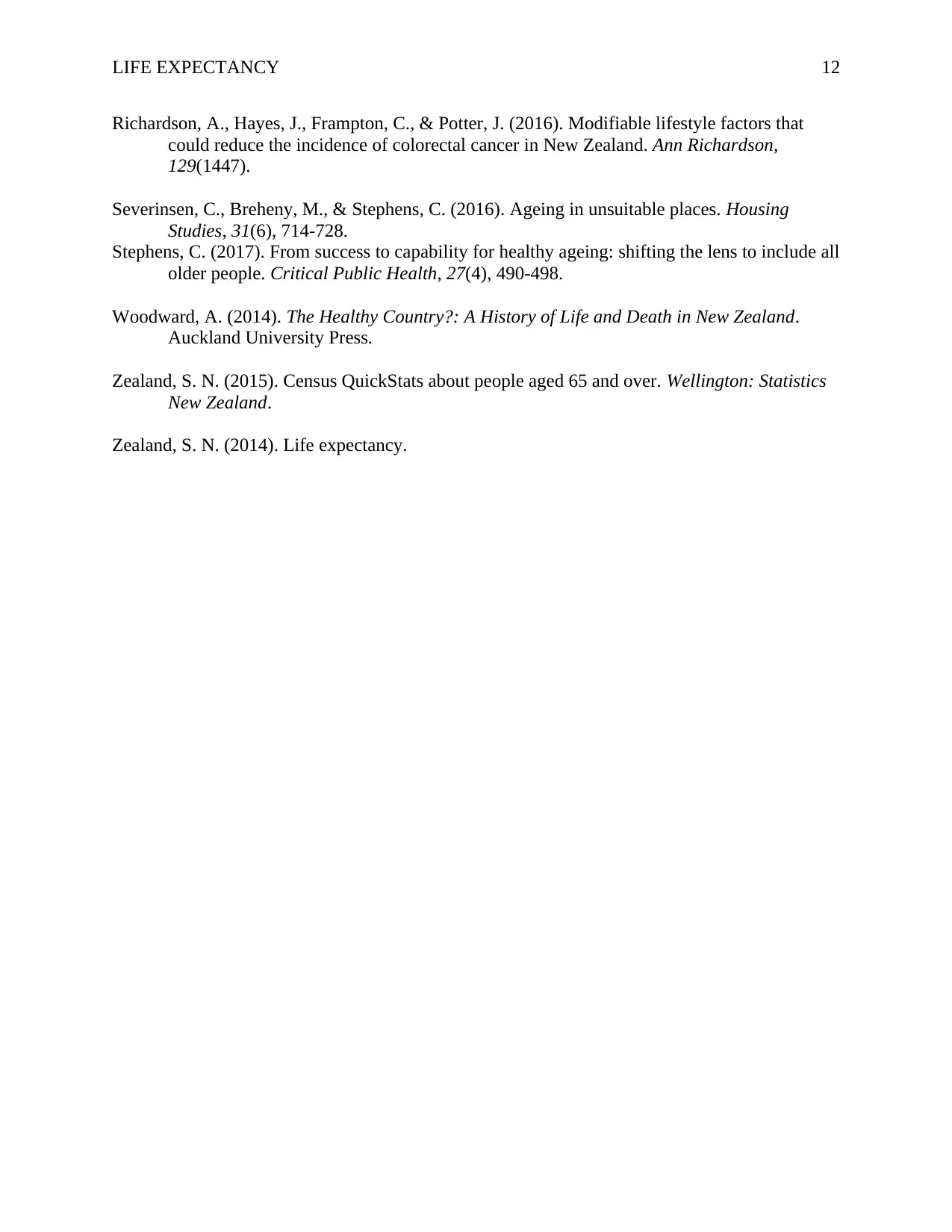
LIFE EXPECTANCY 12
Richardson, A., Hayes, J., Frampton, C., & Potter, J. (2016). Modifiable lifestyle factors that
could reduce the incidence of colorectal cancer in New Zealand. Ann Richardson,
129(1447).
Severinsen, C., Breheny, M., & Stephens, C. (2016). Ageing in unsuitable places. Housing
Studies, 31(6), 714-728.
Stephens, C. (2017). From success to capability for healthy ageing: shifting the lens to include all
older people. Critical Public Health, 27(4), 490-498.
Woodward, A. (2014). The Healthy Country?: A History of Life and Death in New Zealand.
Auckland University Press.
Zealand, S. N. (2015). Census QuickStats about people aged 65 and over. Wellington: Statistics
New Zealand.
Zealand, S. N. (2014). Life expectancy.
Richardson, A., Hayes, J., Frampton, C., & Potter, J. (2016). Modifiable lifestyle factors that
could reduce the incidence of colorectal cancer in New Zealand. Ann Richardson,
129(1447).
Severinsen, C., Breheny, M., & Stephens, C. (2016). Ageing in unsuitable places. Housing
Studies, 31(6), 714-728.
Stephens, C. (2017). From success to capability for healthy ageing: shifting the lens to include all
older people. Critical Public Health, 27(4), 490-498.
Woodward, A. (2014). The Healthy Country?: A History of Life and Death in New Zealand.
Auckland University Press.
Zealand, S. N. (2015). Census QuickStats about people aged 65 and over. Wellington: Statistics
New Zealand.
Zealand, S. N. (2014). Life expectancy.
⊘ This is a preview!⊘
Do you want full access?
Subscribe today to unlock all pages.

Trusted by 1+ million students worldwide
1 out of 12
Related Documents
Your All-in-One AI-Powered Toolkit for Academic Success.
+13062052269
info@desklib.com
Available 24*7 on WhatsApp / Email
![[object Object]](/_next/static/media/star-bottom.7253800d.svg)
Unlock your academic potential
© 2024 | Zucol Services PVT LTD | All rights reserved.





